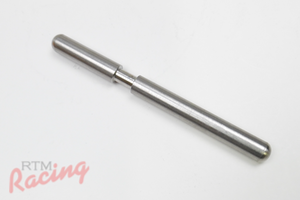|
Home
::
MITSUBISHI / EAGLE
::
DSM: 2g (1995-99)
::
Drivetrain & Transmission
::
Seals, External Tranny Components
::
RTM Extended Clutch Slave Cylinder Pushrod: DSM/EVO 1-3
|
RTM Extended Clutch Slave Cylinder Pushrod: DSM/EVO 1-3

Categories
- New at RTM Racing
-
MITSUBISHI / EAGLE
- Eclipse / Talon / Laser
-
DSM: 1g (1990-94)
- Maintenance
- OEM Hardware
- Body & Exterior
-
Brakes
- Brake Upgrades
- Calipers
- Lines
- Rotors
- Pads
- Master Cylinder, Brake Booster, Proportioning Valve
- Parking Brake Cables, Hardware, etc
- Cooling
- Drivetrain & Transmission
- Engine
- Engine Management
- Exhaust
- Fuel
- Gauges
- Ignition & Electrical
- Intake
- Intercooler
- Interior
- Meth/Water Injection
- Suspension & Steering
- Turbo
- Wheels
- Safety
- Special Tools
-
DSM: 2g (1995-99)
- Maintenance
- OEM Hardware
- Body & Exterior
-
Brakes
-
Brake Upgrades
- 3000GT-VR4/Cobra Front Big Brake Upgrade
- 3000GT-VR4/Genesis Front Big Brake Upgrade
- Wilwood Front Big Brake Upgrade
- EVO 5-9 (Brembo) Front Big Brake Upgrade
- CTS-V (Brembo) Front Big Brake Upgrade
- Ford Cobra Front Big Brake Upgrade
- Outlander Front Big Brake Upgrade
- EVO 5-9 (Brembo) Rear Big Brake Upgrade
- Calipers
- Lines
- Rotors
- Pads/Shoes
- Master Cylinder, Brake Booster, Proportioning Valve
- Parking Brake Cables, Hardware, etc
- Brake Fluids
-
Brake Upgrades
- Cooling
- Drivetrain & Transmission
- Engine
- Engine Management
- Exhaust
- Fuel
- Gauges
- Ignition & Electrical
- Intake
- Intercooler
- Interior
- Meth/Water Injection
- Suspension & Steering
- Turbo
- Wheels
- Safety
- Special Tools
- Penetrants, Anit-Seize, Rust Removal
- DSM: 2gNT (1995-99)
-
EVO: I-III (1992-96)
- Maintenance
- OEM Hardware
- Body / Exterior
- Brakes
- Cooling
- Drivetrain & Transmission
- Engine
- Engine Management
- Exhaust
- Fuel
- Gauges
- Ignition & Electrical
- Intake
- Intercooler
- Interior
- Meth/Water Injection
- Suspension & Steering
- Turbo
- Wheels
- Safety
- Special Tools
- Penetrants, Anit-Seize, Rust Removal
-
EVO: IV-VI (1996-01)
- Maintenance
- OEM Hardware
- Body / Exterior
- Brakes
- Cooling
- Drivetrain & Transmission
- Engine
- Engine Management
- Exhaust
- Fuel
- Gauges
- Ignition & Electrical
- Intake
- Intercooler
- Interior
- Meth/Water Injection
- Suspension & Steering
- Turbo
- Wheels
- Safety
- Special Tools
- Penetrants, Anit-Seize, Rust Removal
-
EVO: VII-IX (2001-07)
- Maintenance
- Body / Exterior
- Brakes
- Cooling
- Drivetrain & Transmission
- Engine
- Engine Management
- Exhaust
- Fuel
- Gauges
- Ignition & Electrical
- Intake
- Intercooler
- Interior
- Meth/Water Injection
- Suspension & Steering
- Turbo
- Wheels
- Safety
- Special Tools
- Penetrants, Anit-Seize, Rust Removal
-
EVO: X (2008-15)
- Maintenance
- OEM Hardware
- Body & Exterior
- Brakes
- Cooling
- Drivetrain & Transmission
- Engine
- Engine Management
- Exhaust
- Fuel
- Gauges
- Ignition & Electrical
- Intake
- Intercooler
- Interior
- Meth/Water Injection
- Suspension & Steering
- Turbo
- Wheels
- Safety
- Special Tools
- Penetrants, Anit-Seize, Rust Removal
- Galant VR4 (1988-97)
- 3000GT (1991-99)
- Lancer / Ralliart
- OEM Hardware
-
Universal
- Air Filters
- Anti-Seize
- Banjo Bolts & Fittings
- Batteries & Battery Boxes
- Blowoff Valves
- Body Accessories
- Boost Controllers
- Brake Accessories
- Catch Cans
- Couplers
- CV Boot Clamps
- Engine Bay Grounding Kits
- Engine Management
- Exhaust
- Fire Extinguishers
- Fluids
- Fuel
- Fuses
- Gauges
- Heat Shields, Wraps, Coatings
- Hood Pins & Latches
- Hose
- Hose Clamps
- Hose Ends & Fittings
- Intercooler
- Interior Accessories
- Magnetic Oil Drain Plugs
- Meth/Water Injection
- Oil & Transmission Coolers
- Penetrants
- Plumbing
- Racing Seats
- Rad Fans, Rad Caps, Accessories
- Rust Removal
- Scan Tools (OBDII)
- Shift Knobs
- Silicone Couplers
- Surge Tanks
- T-Bolt Clamps
- Throttle Bodies
- Turbo
- Turbo Timers
- V-Band Clamps
- Vacuum Hose
- Wastegates
- Weld Bungs
- Wheel Accessories
- Wideband O2
- Window Stickers
- Windshield Wipers
- Y-Blocks
- Hard-to-Find Parts
- Bargain Bin
- Made by RTM
- Search don't Surf

Cart is empty

Manufacturers
Users online:
440
anonymous customer(s)
Powered by X-Cart shopping cart software
Copyright © 2003-2024 RTM Racing

